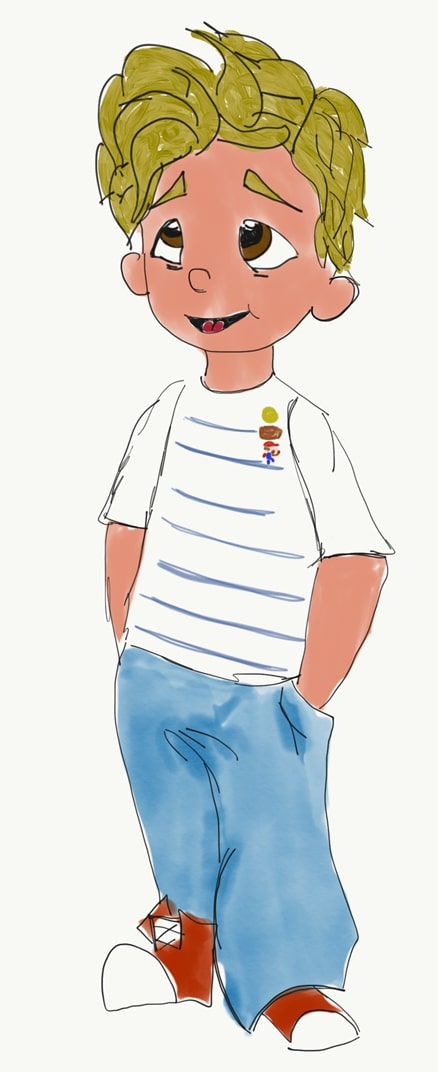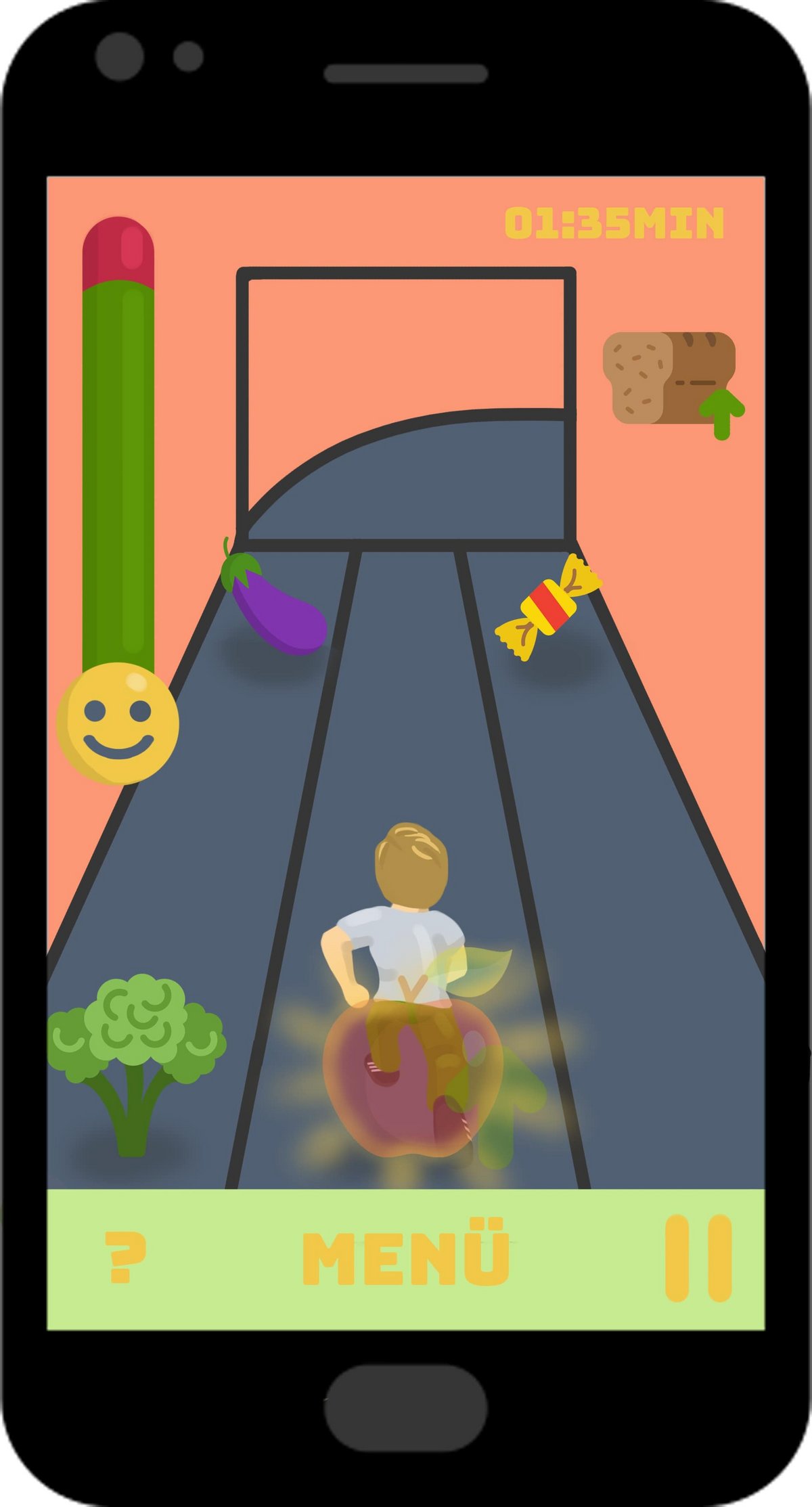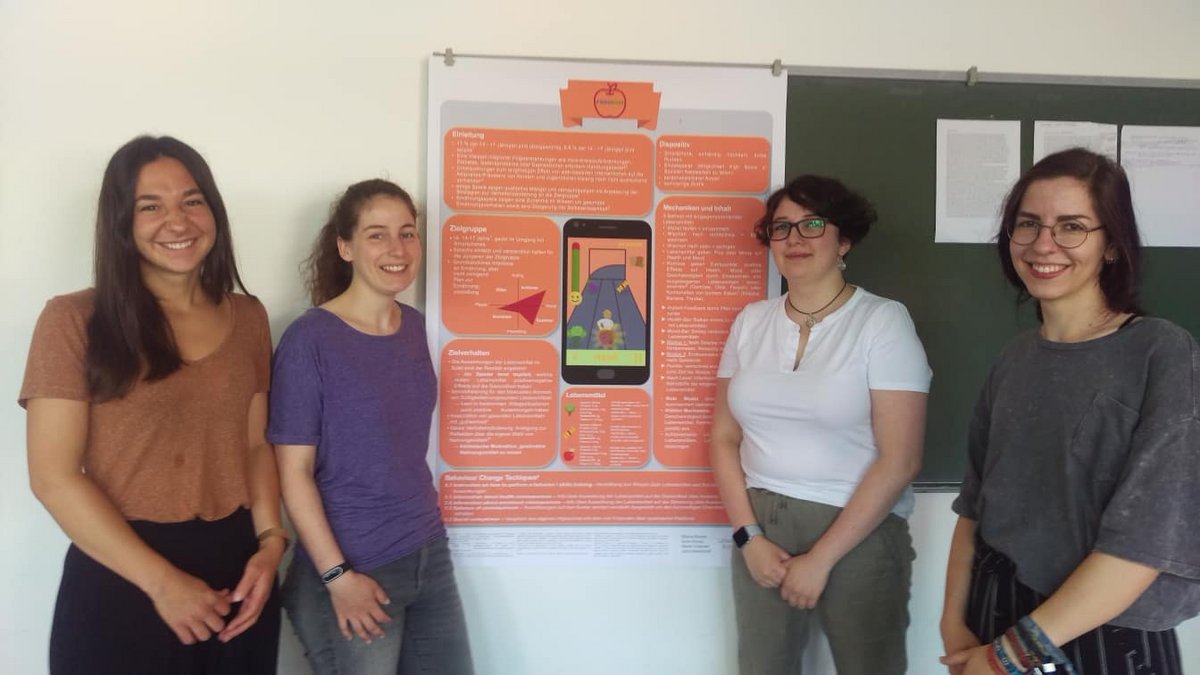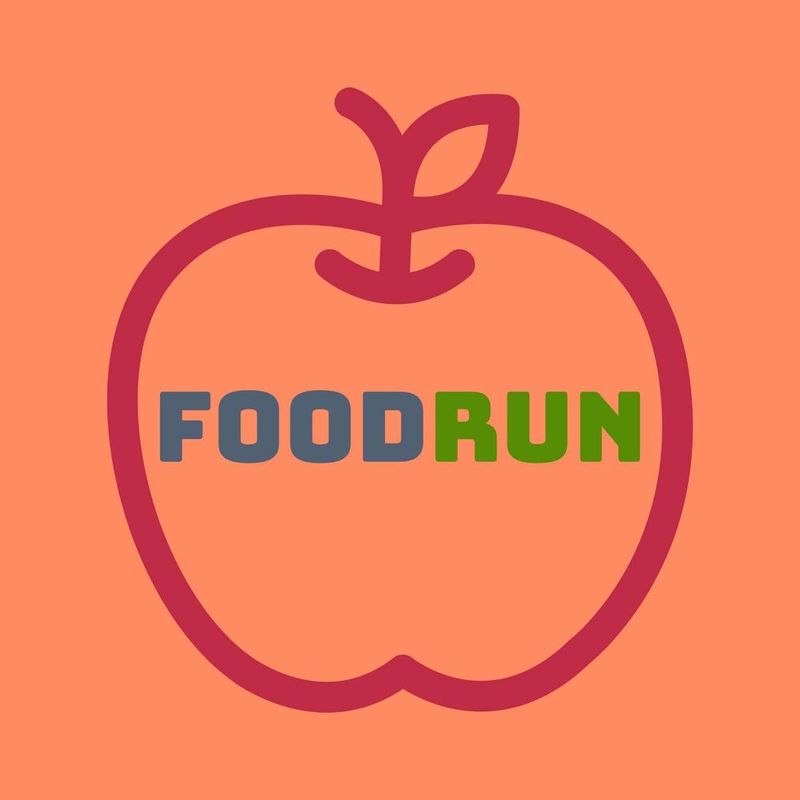Studies show that a disturbingly large proportion of young people are overweight, and a not inconsiderable percentage are even obese (cf. Kurth & Rosario 2007). The multitude of secondary health diseases poses a danger, especially at such a young age. While science does not yet have sufficient results on the long-term success of so-called Games for Health (cf. Weihrauch-Blüher et al. 2016), some nutrition games at least show an effect on the awareness of (healthy) nutrition behavior (Orji et al. 2013). Unfortunately, many of these games and apps have qualitative deficiencies, both in terms of the information provided and the strategies for changing dietary behavior (cf. Schoeppe et al. 2017).
The FoodRun game created in the Games for Health seminar picks up where we left off. Based on a small selection of Behaviour Change Techniques (BCTs), our group, consisting of two students each from Media Science and Psychology, created a concept for a game that should be both high quality and appealing to our target group.
What is FoodRun?
FoodRun is a game for the smartphone that aims to convey a feeling for healthy and unhealthy nutrition. The player collects different foods with an avatar, gets a visual representation of possible effects and receives information about the ingredients of the food.
Target group
Our target group refers to the sample of 14-17 year olds examined in the study mentioned above (Kurth & Rosario 2007). We decided to locate our target group in Central Europe for several reasons: first, we are sufficiently familiar with local food consumption, which enables us to make an appealing selection of popular foods. Furthermore, in the Central European area we have an almost inexhaustible access to food from other countries, which allows us to keep the game interesting for a longer period of time with exotic foods. And finally, of course, the average weight gain of the population in Europe is also a serious problem.
Our players* must have a smartphone and should also be skilled in using it. The language of the game is kept simple and understandable, especially for the younger ones. However, we assume that a certain basic understanding is present; the young people should have already heard terms such as vitamins or proteins. Furthermore, there should be a basic interest in (healthy) nutrition, even if there is not necessarily a desire to change one's diet.
Dispositive and game mechanics
As mentioned above, our game is an app for smartphones. This, in combination with short rounds, should provide more mobility and enable the player to play anywhere. The one-handed operation also contributes to this, so that you can hold on to the bus at the same time, for example. The graphics are more comic-like in order to make the game elements more recognizable.

The game starts with the insertion of a "Role Model", also called "Quarterback" in our development phase. This is a friendly person with a healthy physique whose purpose is to encourage the player to eat healthily. At this point, the Role Model briefly introduces herself/himself and then asks the player to create an avatar. The avatar offers a wide range of design options so that the player can identify with it as much as possible. This raises awareness of nutrition, since the avatar also changes its weight depending on the "diet" in the game.

After creating the avatar, the Role Model explains the mechanics of the game: the character runs on three lanes while food is coming towards him. This can be only one on a track, but also two or three in a row. The player must now decide whether to collect the food by running over it, jump or move to another lane. This is done by wiping upwards or to the left or right. When collecting the food, the player gets a short, direct feedback on the "health" of the food in the form of an arrow pointing up or down. Furthermore, the last collected food and its effect is displayed at the top. For the sake of clarity, we want to have a maximum of ten different foods in a level.
We deliberately decided not to set a symbolic death of the character as the end of the round, as this would undermine morale and the sense of a health game. Instead, we came up with two modes: in the first mode, we set a track of about 40 food items in a row. The entire level naturally contains more food if it occurs not only behind but also next to each other. The player encounters about 15 food items per minute. We measured this number ourselves based on the obstacles in Temple Run, in order to be able to estimate what number of obstacles can be perceived as pleasant. A bar is displayed on the side of the screen, the health scale. This increases with healthy foods and decreases with unhealthy foods. The smiley represents the mood of the avatar. We don't want to demonize unhealthy foods from the ground up, but rather include them in the consciousness of our players. Therefore, sweets, for example, give a plus to mood, but a minus to health. We also want to promote varied food, in that too many of the same food in a row also give a minus on the mood, whereas combos by "colorful" food give extra points. However, the foods have another property: for example, sweets give a sugar shock, which makes the figure faster, but after a short time significantly slower. Keeping up the colorful combos, on the other hand, leads to a steady increase in speed. At the end, the health and mood points are added to the time needed and the combo points, giving a total score for the round.
The second mode is a kind of "fun mode" that lets the character run indefinitely until the player decides to finish the level. Here, health and mood points are also calculated, but with the distance covered in the required time.
After the level, an information page is displayed on which the player can see the exact ingredients of the food he/she has collected. Food collected in other rounds can be looked up in a logbook via the main menu. We had originally planned a series of recipe suggestions at this point, but with the narrowing of our target group decided that this is not yet particularly interesting for 14-17 year olds.
A certain number of points and achievements can then be used to unlock more food or design options for the avatar. In addition, it will be possible to share the avatar, unlocked food and high scores on social networks.
Each time the app is started, the Role Model appears first, commenting on the last rounds of the game and providing further encouragement in the case of healthy "nutrition" or referring to it in the case of unhealthy. In addition, the Role Model can give tips, for example, which foods give the best boost or which should be avoided one right after the other.
BCTs
The term BCT comes from psychology and stands for Behaviour Change Technique(s). As the name suggests, these are different ways of eliciting behavior change. Michie et al. (2015) categorized these into different groups. We incorporated the following BCTs into our game:
4.1 Instruction on how to perform a behavior / skills training - providing knowledge about food and its physical effects.
5.1 Information about health consequences - info about impact of food on health (of the avatar).
5.6 Information about emotional consequences - information about the impact of food on mood (of the avatar).
5.2 Salience of consequences - effects on the avatar are presented more intensively in order to maintain the entertaining character of the game.
6.2 Social comparison - comparison of the own high score with that of friends via the game-internal platform.
Final spurt: Target behavior
Since we know (partly from our own experience) that the motivation to change one's diet wears off very quickly, we wanted to design a game that is first and foremost fun. We want the player to play the game primarily because he/she likes it, and then secondarily to learn something from it. He/she should be sensitized to the conscious consumption of healthy and unhealthy foods and implicitly learn through the mechanics of the game which foods can have a good or bad influence on his/her health. We are aware that foods cannot be categorized sweepingly as good or bad, and that the effects on health are sometimes very exaggerated. However, after lengthy discussions, we felt compelled to retain this in order to be able to sufficiently convey the necessary knowledge in the context of a short round.
Ideally, the player will also associate healthy food with "good" in the real world through our game and learn to enjoy unhealthier food with caution. We hope to stimulate reflection on one's own diet and increase intrinsic motivation to consume healthier foods.

Quellen
Kurth, B. M., & Rosario, A. S. (2007). Die Verbreitung von Übergewicht und Adipositas bei Kindern und Jugendlichen in Deutschland. Bundesgesundheitsblatt- Gesundheitsforschung-Gesundheitsschutz, 50(5-6), 736-743.
Michie, S., Wood, C. E., Johnston, M., Abraham, C., Francis, J. J., & Hardeman, W. (2015). Behaviour change techniques: the development and evaluation of a taxonomic method for reporting and describing behaviour change interventions (a suite of five studies involving consensus methods, randomised controlled trials and analysis of qualitative data). Health Technology Assessment (Winchester, England), 19(99), 1–188. doi.org/10.3310/hta19990.
Orji, R., Mandryk, R. L., Vassileva, J., & Gerling, K. M. (2013). Tailoring persuasive health games to gamer type. In Proceedings of the SIGCHI Conference on Human Factors in Computing Systems (pp. 2467-2476). ACM. 6 Andersson, A., & Bryngelsson, S. (2007). Towards a healthy diet: from nutrition recommendations to dietary advice. Scandinavian Journal of Food and Nutrition, 51(1), 31–40.
Schoeppe, S., Alley, S., Rebar, A. L., Hayman, M., Bray, N. A., Van Lippevelde, W. & Vandelanotte, C. (2017). Apps to improve diet, physical activity and sedentary behaviour in children and adolescents: a review of quality, features and behaviour change techniques. International Journal of Behavioral Nutrition and Physical Activity, 14(1), 83.
Weihrauch-Blüher, S., Koormann, S., Brauchmann, J., & Wiegand, S. (2016). Elektronische Medien in der Adipositas-Prävention bei Kindern und Jugendlichen. Bundesgesundheitsblatt-Gesundheitsforschung-Gesundheitsschutz, 59(11), 1452-1464.
Icons: www.flaticon.com
Smartphone-Umriss, Aubergine, Apfel von Freepik.
Brot, Bonbon, Brokkoli von Smashicons.

